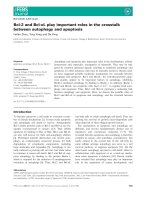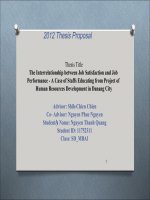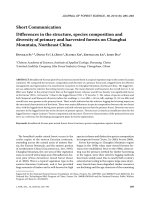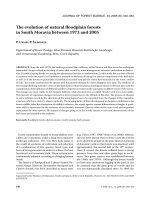Cognitive differences in collaborative design between architectural and industrial design processes case of building project related product design
Bạn đang xem bản rút gọn của tài liệu. Xem và tải ngay bản đầy đủ của tài liệu tại đây (6.63 MB, 156 trang )
COGNITIVE DIFFERENCES IN COLLABORATIVE DESIGN
BETWEEN ARCHITECTURAL AND INDUSTRIAL DESIGN
PROCESSES: CASE OF BUILDING PROJECT-RELATED
PRODUCT DESIGN
LI SUPING
NATIONAL UNIVERSITY OF SINGAPORE
2003
COGNITIVE DIFFERENCES IN COLLABORATIVE DESIGN
BETWEEN ARCHITECTURAL AND INDUSTRIAL DESIGN
PROCESSES: CASE OF BUILDING PROJECT-RELATED
PRODUCT DESIGN
LI SUPING
(B.Arch, Southeast University)
A THESIS SUBMITTED
FOR THE DEGREE OF MASTER OF ARTS (ARCHITECTURE)
DEPARTMENT OF ARCHITECTURE
NATIONAL UNIVERSITY OF SINGAPORE
2003
Dedicated to my parents
Acknowledgements
Acknowledgements
I would like to express my deepest appreciation to the people who helped make this work
possible. First and foremost, I would like to convey my sincere gratitude to Mr. Andre
Liem and Dr. Philip Bay, my thesis supervisors, for their patient guidance and support. I
also convey my gratitude to all the professors at National University of Singapore who
helped me refine my views throughout this dissertation- Dr. Pinna Indorf for helping me
focus my research, Mr. Thiagarajan Sabapathy for his instruction on research
methodology, Dr. Christian Boucharenc and Dr. Yen Ching Chiuan for their valuable
comments from an industrial design perspective, and Mr. Alan Woo. I also own my
appreciation to Mr. Alan J Brooks and Dr. Mieke Oostra of Delft University of
Technology. Their valuable advice and insights on this topic inspired me in my research.
Special thanks go to DP Architects, MERO GmbH & Co, and MERO Asia Pacific Pte Ltd
for allowing the use of one of their projects, and documentations as materials for a case
study. I would like to convey my best gratitude to Mr. Vikas Gore, the project director and
a director of DP Architects, for his continuing help and cooperation. My sincere thank also
goes to Mr. Claus Kaspar, the project manager of MERO GmbH & Co, and Mr. Vino
Preetham of MERO Asia Pacific Pte Ltd. I also thank Mr. Steven Gan of DP Architects,
for helping me sort the large volumes of drawings. Without their help, the case study
presented here would not have been possible.
i
Acknowledgements
I also thank my colleagues in Center for Advanced Studies in Architecture (CASA) at
NUS: Li Ao, Tan Pei Tze Josephine, Zhou Yuliang, Newton Santosh D'Souza, Chen Yu,
Huang Yan, Hu Xia, Xie Hongyan, Archana Sharma, Chong Keng Hua, Kallianpur
Virendra, N A D Senaka Dharmatilleke, Simon Yanuar Putra, Tan Kar Lin, Ten Leu Jiun,
Yeo Kang Shua, and others. Their friendship and advice have been invaluable to me.
Finally, I am forever grateful to my family for the countless ways they have contributed to
my work. I would like to thank my parents for their continuous and unconditional support.
Especially, however, I must extend very special thanks to my husband, Tian Yang. His
love, support, and encouragement make this research a more enjoyable experience.
ii
Table of contents
TABLE OF CONTENTS
Acknowledgements................................................................................................... i
TABLE OF CONTENTS....................................................................................... iii
Summary .............................................................................................................. vi
List of Figures ....................................................................................................... viii
List of Tables........................................................................................................... xi
Introduction ............................................................................................................. 1
Brief background ............................................................................................................2
Problem statement ..........................................................................................................5
Research framework.......................................................................................................5
Cognitive framework.....................................................................................................6
1. A representation of design reasoning ....................................................................6
2. Two types of design differences .............................................................................9
3. A general comparative study between architectural and industrial design ........10
Case study approach...................................................................................................10
Outline of the thesis ......................................................................................................12
Chapter 1: Collaborative design of building project-related product under
mass customization
Background, research problem statement, and literature review
1.1.
The state-of-the-art of Prefabrication: from mass production to mass
customization ....................................................................................................15
1.1.1. The status quo of prefabrication....................................................................16
1.1.2. From mass production to mass customization...............................................17
1.2. Building project-related product.....................................................................19
1.2.1. What is project-related product.....................................................................19
1.2.2. Why project-related product..........................................................................21
1.3. Problems of collaborative design of project-related product .......................22
1.3.1. Three levels of design: product, activity, and thinking..................................22
1.3.2. Product level: Problems in the integration ...................................................24
1.3.3. Activity level: Fragmentation in design processes ........................................26
1.3.4. Thinking level: Design differences between architectural and industrial
design .......................................................................................................................29
1.4.
Summary............................................................................................................34
iii
Table of contents
Chapter 2: Differences in architectural and industrial design thinking
A cognitive framework to explore design difference in collaborative
design thinking
2.1.
A representation of design reasoning..............................................................36
2.2. Design difference in collaboration...................................................................39
2.2.1. Defining design difference and design conflict .............................................39
2.2.2. Two types of design differences in collaboration ..........................................40
2.3. A comparative study of architectural and industrial design ........................43
2.3.1. Nature of building and product .....................................................................46
2.3.2. The requirements of practice .........................................................................49
2.3.3. Differences in design constraint ....................................................................55
2.4.
Summary............................................................................................................57
Chapter 3: A case study - Esplanade -Theatres on the Bay, Singapore
Design differences in the roof cladding system design: a description at
a product and an activity level
3.1. Objective and method of the case study..........................................................59
3.1.1. Objective of the case study ............................................................................59
3.1.2. Selection Criteria of a specific project for the case study .............................60
3.1.3. Data sources of the case study.......................................................................61
3.2. Description of the project.................................................................................62
3.2.1. System products and special products in the roof cladding system...............63
3.2.2. Design practice process.................................................................................64
3.3. Three scenarios of collaborative design ..........................................................65
3.3.1. Non-collaborative design process: non-collaborative scenario....................66
3.3.2. Collaborative design process: semi-collaborative and full-collaborative
scenario.......................................................................................................................67
3.4. Design differences in the design of the roof cladding system........................68
3.4.1. Design differences in customization of system products ...............................69
3.4.2. Design differences in development of special products.................................75
3.5.
Summary............................................................................................................79
iv
Table of contents
Chapter 4: Understaning design difference in collaborative design
Exploring how design differences arise within the cognitive framework:
an analysis and discussion at a thinking level
4.1.
Analytical framework of the case study..........................................................81
4.2. Design differences in the customization process of system product.............82
4.2.1. Design difference 1: structural design ..........................................................82
4.2.2. Design difference 2: connection design of the glazing layer.........................89
4.2.3. Advantage of collaboration: Design difference 1&2.....................................93
4.3. Design differences in the development process of special product...............96
4.3.1. Design difference 3: connection design of the sun-shading panel ................97
4.3.2. Design difference 4: shape design of the sun-shading panels.....................102
4.3.3. Advantage of collaboration: Design difference 3&4...................................108
4.4.
The implications ..............................................................................................108
4.5.
Summary..........................................................................................................112
Conclusion ........................................................................................................... 114
Reference ........................................................................................................... 120
APPENDIX A
Illustrations of a specific project-related product................................................. 126
APPENDIX B
Design practice process of a specific project-related product ............................. 128
APPENDIX C
Discussions between the author and Mr. Vikas M Gore of DP Architects ........... 133
APPENDIX D
Discussions between the author and Mr. Claus Kaspar of MERO GmbH & Co . 137
v
Summary
Summary
This study aims at establish a model of design differences in the collaborative design
between architectural and industrial design processes based on a case study. To achieve
this purpose, the following questions are formulated:
1. What kinds of design differences can arise in the collaboration?
2. When do these design differences arise?
3. How do these design differences arise?
Due to the progressive application of mass customization in manufacturing, the
application of building project-related products in building industry is rapidly increasing.
As a result, some stages of an architectural design process overlap with and are even
substituted by an industrial design process. The collaboration between architectural and
industrial design processes can range from almost none to partial, and to fullcollaborations. This inevitably brings about problems with regard to the collaborative
design at various levels: 1) integration of prefabricated products and specific buildings
they serve at a product level, 2) fragmentation of design processes at an activity level, and
3) design differences and conflicts at a cognitive level.
In a collaborative design process some potential design differences and conflicts can
remain unnoticed or implicit at a cognitive level. If they can be made explicit, more efforts
can be put into integrating the design differences and resolving any possible design
conflicts, and thus the design quality may be improved.
vi
Summary
In this study, we aim to explore the collaborative design processes with a cognitive
framework. Following a general comparison of design thinking between architectural and
industrial design, a case study is employed to look at the structure and elements of design
thinking of an actual building project. In the case study of Esplanade-Theatres on the Bay,
Singapore, two types of design differences in the collaborative design processes of the
project-related products, which include both system products and special products, are
observed and analyzed. The Kernel of Conceptual System (Tzonis et al. 1978), which is a
suitable theory with the key elements and structure for beliefs, judgement, and decision
making, is applied to make the structure and elements of design thinking explicit for
comparison. With the design reasoning processes having been mapped explicitly, the
points of differences, levels of connections, and how they arise can be understood more
clearly. With these findings, some understandings in terms of design differences at a
cognitive level are derived for the future application of collaborative design of building
project-related products.
The findings of this research are expected to shed light on the existing problems in
building project-related product design with regard to the collaboration of architectural
and industrial design processes. Increasing the general awareness of cognitive design
differences should lead to a better understanding of collaborative design in practice. Based
on the model developed in this study, further machine-based models of design difference
detection can be developed to facilitate practitioners in collaborative design processes.
vii
List of Figures
List of Figures
Figure 1: The historical influence of external factors on prefabrication (Gibb 1999, 10)..18
Figure 2: Three levels of design..........................................................................................23
Figure 3: Problems associated with the collaborative design between architectural and
industrial design processes at different design levels .......................................24
Figure 4: The deontic branch of the Kernel of Conceptual System (Tzonis et al. 1978, 6) 37
Figure 5: A linear sequence of arguments (Tzonis et al. 1978, 7) ......................................38
Figure 6: The Kernel of Conceptual System with Backing module (Tzonis et al. 1978, 9)38
Figure 7: The Kernel of Conceptual System with Base module (Tzonis et al. 1978, 9) ....38
Figure 8: A diagram of Type I Design Difference formation .............................................41
Figure 9: A diagram of Type II Design Difference formation............................................42
Figure 10: Relationship between user, building, and environment ....................................47
Figure 11: Relationship between user, product, and environment......................................47
Figure 12: Relationship between user, product, building, and environment ......................48
Figure 13: Architecture designing and product designing (Jager 2002).............................50
Figure 14: Options for allocating design responsibilities (Haviland 1998, 464)................53
Figure 15: Exterior view of the two domes .......................................................................64
Figure 16: The roof cladding system ..................................................................................64
Figure 17: Three scenarios in the design process of the roof cladding system...................66
Figure 18: Support structure design in the non-collaborative scenario: Section of concert
hall across East and West (Source: DP Architects) ..........................................70
Figure 19: Support structure design in the semi-collaborative scenario: concert hall layout
(Source: MERO GmbH & Co) .........................................................................71
Figure 20: Support structure design in the non-collaborative scenario (Source: DP
Architects).........................................................................................................72
viii
List of Figures
Figure 21: Support structure design in the semi-collaborative scenario (Source: MERO
GmbH & Co) ....................................................................................................72
Figure 22: Interior view of the support structure (Source: Author)....................................72
Figure 23: Connection design of the glazing layer in the non-collaborative scenario
(Source: DP Architects) ....................................................................................74
Figure 24: Connection design of the glazing layer in the semi-collaborative scenario
(Source: MERO GmbH & Co) .........................................................................74
Figure 25: A prototype of the connection of the glazing layer in the full-collaborative
scenario(Source: DP Architects).......................................................................74
Figure 26: A model of the sun-shading layer design in the non-collaborative scenario
(Source: Author) ...............................................................................................75
Figure 27: Connection design of the sun-shading panels in the full-collaborative scenario:
the ball joint system (Source: MERO GmbH & Co) ........................................76
Figure 28: Connection design of the sun-shading panels in the full-collaborative scenario:
section of side fixing of shading panel (Source: MERO GmbH & Co) ...........76
Figure 29: Connection design of the sun-shading panels in the non-collaborative scenario
(Source: DP Architects) ....................................................................................77
Figure 30: Connection design of the sun-shading panels in the semi-collaborative scenario
(Source: MERO GmbH & Co) .........................................................................77
Figure 31: Connection design of the sun-shading panels in the full-collaborative scenario
(Source: MERO GmbH & Co) .........................................................................77
Figure 32: Shape design of the sun-shading panels in the non-collaborative scenario
(Source: DP Architects) ....................................................................................78
Figure 33: Shape design of the sun-shading panels in the semi-collaborative scenario
(Source: MERO GmbH & Co) .........................................................................78
Figure 34: Shape design of the sun-shading panels in the full-collaborative scenario
(Source: MERO GmbH & Co) .........................................................................78
Figure 35: A diagram of design difference 1 (i.e. structure design) formation ..................87
Figure 36: MERO space-frame structure node proposed by MERO in semi-collaborative
design scenario..................................................................................................88
ix
List of Figures
Figure 37: Connection design of the support structure in the full-collaborative scenario:
bottom node section with MERO-KK members (Source: MERO GmbH & Co)
..........................................................................................................................88
Figure 38: A diagram of design difference 2 (i.e. connection design of the glazing layer)
formation...........................................................................................................92
Figure 39: A diagram of design difference 3 (i.e. connection design of the sun-shading
layer) formation ..............................................................................................100
Figure 40: A diagram of connection design of the sun-shading panels in the fullcollaborative scenario .....................................................................................101
Figure 41: A diagram of design difference 4 (i.e. shape design of the sun-shading panels)
formation.........................................................................................................105
Figure 42: A diagram of shape design of the sun-shading panels in the full-collaborative
scenario ...........................................................................................................106
Figure 43: Type I Design difference solution in a collaborative design scenario ............110
Figure 44: A framework for digital system and interface between an architectural design
process and an industrial design process ........................................................111
x
List of Tables
List of Tables
Table 1: A comparison of nature of building and product..................................................46
Table 2: A comparison of practice requirements................................................................49
Table 3: A comparison of design constraints......................................................................56
Table 4: Description of design difference 1: design of the support structure .....................72
Table 5: Description of design difference 2: connection design of the glazing layer.........74
Table 6: Description of design difference 3: connection design of the sun-shading panels
.............................................................................................................................77
Table 7: Description of design difference 4: shape design of the sun-shading panels .......78
Table 8: Norms in design difference 1: structure design ....................................................85
Table 9: Norms in design difference 2: connection design of the glazing layer.................91
Table 10: Key design differences in customization of the system products and advantages
of collaboration: ...................................................................................................95
Table 11: Norms in design difference 3: connection design of the sun-shading panels.....99
Table 12: Norms in design difference 4: shape design of the sun-shading panels ...........104
Table 13: Key design differences in development of the special product and advantages of
collaboration ......................................................................................................107
xi
Introduction
Introduction
This study aims to investigate the collaboration of architectural and industrial design
processes from the cognitive aspect of design differences formation. More specifically, it
aims to establish a model of design differences in the collaborative design between
architectural and industrial design processes based on a case study. To achieve this
purpose, the following questions are formulated:
1. What kinds of design differences can arise in the collaboration?
2. When do these design differences arise?
3. How do these design differences arise?
According to their relationship with building projects, prefabricated products can be
divided into two categories, i.e. Project-independent products and Project-related
products (Oostra 2000).1 Project-independent products are standard products, which can
be manufactured independently without clients being involved; while Project-related
products include both special products and system products, which are usually customized
for specific building tasks by complying with requests from clients (Please refer to section
1.2). This study mainly focuses on the collaborative design processes of Project-related
products.
In the design of a project-related product two design processes are involved: an
architectural design process and an industrial design process. In this study the term
1
In this study, the terms prefabricated product, architectural product and building product are used
interchangeably.
1
Introduction
industrial design process is used in its broad sense, which comprises the process of design
and development of a product. It is assumed that an architectural design team refers to the
one that works in a consulting firm, while an industrial design team in a manufacturing
firm. This is usually the common setting in practice in terms of project-related product
design and development in building industry. An architectural design team and an
industrial design team are considered as two homogenous groups, which have their own
beliefs and normative systems in architectural and industrial design respectively (please
refer to Chapter 2).
Brief background
The widespread application of prefabricated products in building industry has made
prefabrication an indispensable part of a building process. The levels of complexity and
the extent of its application are increasing despite the fact that they are varied according to
different projects. With mass-customization taking over the advance from massproduction in manufacturing, more potential is being offered for the application of projectrelated products in building projects cost-effectively. In this context, some parts of
architectural design responsibilities have been transferred to industrial design and some
stages of an architectural design process overlap with and are even substituted by an
industrial design process. This inevitably brings about problems at various levels: 1)
integration of prefabricated products and specific buildings they serve at a product level, 2)
fragmentation of design processes at an activity level, and 3) design differences and
conflicts at a cognitive level (please refer to section 1.3). The collaboration between
2
Introduction
architectural and industrial design can range from almost none to partial, and to fullcollaborations. It is different from the collaboration between architectural design and other
design domains such as structure engineering and mechanical engineering since it
involves a production-contract situation. It is also different from the collaboration between
architectural design and construction as it requires more sharing of design responsibilities.
Some studies in terms of collaborative design of project-related products have emerged at
the product and activity level, however few studies have been done at a thinking level,
especially with regard to the design differences between architectural and industrial design.
Here the term design difference has dual potentials. One is to be complementary to each
other, while the other is to be contrary to each other. The former has the possibility to be
integrated, while the latter may induce design conflict (please refer to section 2.2).
In the design processes of project-related products, due to the different nature of buildings
and products on the one hand as well as the different requirements, patterns, and habits of
architectural and industrial design practices on the other hand, design differences may
arise. Normally differences tend to be avoided as they may lead to conflicts, which cause
some negative effects. However, from a positive point of view, design differences are
complementary to each other in a sense and have possibilities to be integrated so as to
improve the quality of both architectural and industrial design. In addition, to understand
design differences well can help designers to resolve the potential design conflicts in a
collaborative design process.
3
Introduction
Many scholars have discussed that design team members from different disciplines may
have different views on a problem space, and it thus leads to conflicts in collaboration
(Craig and Craig 2002, Donker 1999, Stempflea and Schaub 2002). Because a design
problem is an ill-defined problem, a design process may include both the problem-finding
and problem-solving processes, which occurs concurrently. Unlike a well-defined problem,
of which the problem space can be settled at the beginning of a problem-solving process, a
design problem space keeps changing during a design process. In a collaborative design
process, on the one hand, the problem spaces of different design teams are dynamic and
updated respectively. On the other hand, the interactions between these design teams will
also help or retard the change of their respective problem spaces due to the differences in
their design thinking. However, how these interactions between different design teams
lead to conflicts in a collaborative design process has not been elaborated clearly and
explicitly.
In a collaborative design process, some potential design differences may remain unnoticed
or implicit. Therefore, if the differences in architectural and industrial design thinking can
be brought to light, and if the implicit design reasoning process that takes place in a
problem space can be made explicit, a better understanding towards the rise of design
differences and conflicts will be achieved. Consequently, more efforts can be put into
integrating the design differences and resolving any possible design conflicts. In this way,
exposing design differences is paramount in improving the effectiveness and efficiency of
collaborative design processes.
4
Introduction
Problem statement
It is hypothesized that:
The design differences, which arise in the collaboration between architectural and
industrial design processes, are linked with the differences in design thinking. Making
these implicit differences explicit can help us better understand what, when, and how
design differences arise, and thereby contributes towards a seamless transition and
collaboration between these two design processes.
The fundamental assumption underlying this study is that a collaborative design process in
terms of building project-related product design is important and necessary and that the
current problems of collaboration are associated with the level of design thinking. There
are other factors that may influence the collaborative design process and its products, such
as the management issues, the social and political factors, etc. However, they are beyond
the scope of this study.
Research framework
The empirical investigation of collaborative design activity is emerging as a vital element
of contemporary design research. Unlike research undertaken prior to the 1990s, which
“tended to focus on ‘de-contextualised’ activity where individuals tackled only small-scale
simulations of real design problems in laboratory-like conditions”, the studies currently
shift their attentions to real-world collaborative design activity (Scrivener et al. 2000, 219).
5
Introduction
According to Omer (1986), the studies of design processes basically adopt two kinds of
approaches. One is bottom-up approach, studying the empirical accounts of design;
another is top-down approach, studying the theoretical accounts of design. For the first set
of studies, they develop empirical models based on empirical study and available theory.
For the second set, they deal with the theoretical issues in the area.
This study adopts a bottom-up approach, aiming to establish a model of design difference
based on a case study of an actual building project in Singapore. Following a comparative
study of architectural and industrial design thinking, an existing design reasoning theory is
applied to map the design reasoning processes in the case study. The findings will be
analyzed and discussed to shed light on the collaborative design process in general, and in
particular, on design differences in the collaboration between architectural and industrial
design processes.
Cognitive framework
1. A representation of design reasoning
Rittel and Webber (1984, 138) stated that a design thinking process is “an argumentative
process in the course of which an image of the problem and of the solution emerges
gradually among the participants, as a product of incessant judgment, subjected to critical
argument”. From this description some common themes for the design process and design
thinking which are relevant to the study can be identified. The first is that a design process
is an argumentative process. The second is that it involves both reasoning by the
individual designer and the discourses among participants in a design project. In this study,
6
Introduction
two sets of terms, argumentation and reasoning, thinking and cognitive are used
interchangeably.
Tzonis et al. (1978, 6) argued that design argumentation includes two processes.2 One is
the process of generating a plan from a program. The other is the process of justifying a
plan in relation to a program. Although the internal design thinking process is basically
implicit, it is believed by augmentation theorists that there are models of super-structure,
by applying which to analyze design discourse, can to a certain degree make explicit the
internal mental process.3
In this study, the Kernel of Conceptual System (Tzonis et al. 1978), which is a suitable
representation of design reasoning with the key elements and structure for beliefs,
judgement, and decision making, is applied to make the structure and elements of design
thinking explicit for comparison.
This method was developed in the framework of a study on the transformation of
architectural thinking between 1650 and 1800, the period during which the modern
thinking and practices of architecture gained full ascendancy over the more archaic
medieval traditions (Tzonis et al. 1978, 1). Tzonis et al. (1978) claimed that it intended to
complement the architectural research approach of the time, which were derived from
natural sciences and focused exclusively on observable and synchronic data of behavior.
2
According to Toulmin et al. (1984, 14), argumentation is “the whole activity of making claims,
challenging them, backing them up by producing reasons, criticizing those reasons, rebutting those
criticisms, and so on.”
3
According to Jeng (1995, 22), “Augmentation theory is a rigorous method to systematically analyze the
representation of arguments – monologue and dialogue.”
7
Introduction
They believed that to study design thinking historically, verbal discourses have the
advantage of reliability and of spelling out more clearly the “mentality” related to
architecture at a given time in history. Therefore they explored a minimum necessary
structure, which can represent the mental structure of the person who thinks about the
architecture. They claimed that this structure is “a primitive universal organization which
is common to any design discourse, in engineering or in planning, in contemporary
debates or in texts of antiquity, in ‘common sense’ conversations or in high culture
discussions” (Tzonis et al. 1978, 3). By applying this structure, a sequence chain of
argumentations can be mapped in correspondence with a hierarchy of norms which leads
to the directives of the solutions to a project. (For detail description of the Kernel of
Conceptual System (Tzonis et al. 1978), please refer to section 2.1)
The Kernel of Conceptual System (Tzonis et al. 1978) has been used successfully in
different types of architectural design research in combination with case studies. In the
research of precedent knowledge, Fang (1993) used it to “develop a framework for the use
of architectural precedent knowledge that combines both architectural and computational
perspectives”. In A Dialogical Model for Participatory Design: A Computational
Approach to Group Planning, Jeng (1995) applied the theory to study the collective
reasoning processes in participatory design, which is relevant to this research though have
different focuses (please refer to section 1.3.4). It was also applied in a study of cognitive
bias specifically in the design of tropical architecture (Bay 2001). In this study, this theory
will be used to analyze a real project in Singapore to make the implicit design reasoning
processes explicit in order to understand the points of design differences, levels of
connections, and how they arise.
8
Introduction
2. Two types of design differences
In design reasoning norms and directives are prescriptive statements, which tell how the
design ought to be.
Norms can be seen as goals, requirements, considerations, and constraints in the
design;
Directives are instructions which generated from the norms to tell how the goals
can be fulfilled;
Backings are descriptive statements, which support certain directives can be
generated from certain norms.
Based on the Structure of Conflicts proposed by Coombs and Avrunin (1988), which can
match with the Kernel of Conceptual System (Tzonis et al. 1978), two types of design
differences are derived according to their formation reasons:
Type I Design Difference is a difference between the directives generated by
parties who have different norms for designing the same product;
Type II Design Difference is a difference between the directives generated by
parties who have different backings to the same norms.
These two types of design differences will be used to understand the formation and
solution of design differences that arise in the collaborative design processes of the case
study. (For more discussion, please refer to Section 2.2)
9
Introduction
3. A general comparative study between architectural and industrial design
Due to the limitations of time, cost, and mental resources, designers usually do not
exhaustively search and scrutinize all the possible problem spaces. Therefore, a problem
space must be narrowed to a certain reasonable size by design constraints. Thus, design
constraints reflect the structures of design problems and influence the goals to be achieved
by designers. In this way design constraints are related to the norms in the structure of the
design reasoning theory.
To examine the different norms of architectural and industrial design, a general
comparative study is conducted. It comprises two parts. Firstly, the different nature of a
building and a product as well as the practice requirements of architectural and industrial
design are juxtaposed and analyzed. Based on the findings, a further comparison is made
between architectural and industrial design with regard to design constraints, which form
the structures of architectural and industrial design problems.
Case study approach
A case study is a qualitative research method, which refers to the description and analysis
of a particular entity (object, person, group, event, state, process, or whatever) and
resembles deductive learning (Fang 1993, 12). It has been widely used in clinical fields
such as psychology and medicine as “case history” and in sociology studies as
“monographic studies” (Hamel et al. 1993, 1). Referring to a more technical definition by
Yin (1984, 23),
A case study is an empirical inquiry that:
10
Introduction
•
•
•
Investigates a contemporary phenomenon within its real-life context; when
The boundaries between phenomenon and context are not clearly evident; and in
which
Multiple sources of evidence are used.
Instead of aiming to achieve statistical generalization, a case study generally tries to attain
analytic generalization (Yin 1984).
In a design process, a series of interrelated decisions is usually made based on a large
number of considerations and factors which have interrelationship with each other in
social, cultural, economic, and technical aspects. Therefore, it is difficult to discuss a
design process in abstraction without reference to its context. A case study is a
representation of a broader phenomenon (collaborative design between architectural and
industrial design processes in this study). The processes in a same design domain are more
or less homogeneous. Accordingly, through a detailed study of a case, which has rich
information and context, some general conclusions and principles can be derived, which
can be applied to a set of other parallel cases similar to it.
In this research, an actual project in Singapore is chosen as a case study (please refer to
Chapter 3). To reduce bias in the case study, the materials of the case are gathered from
multiple sources. Both firsthand materials and secondhand documents of all kinds were
employed. The former include the author’s interviews and correspondences with the
architects, designers, and manufacturers, and the documentations of this project. The latter
includes books, journals, newspapers, websites, and brochures. These full-scale materials
11









